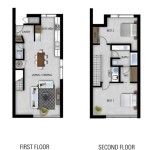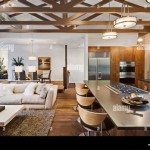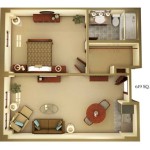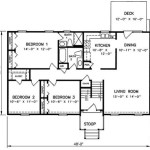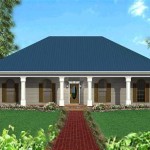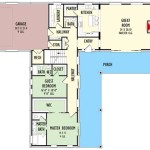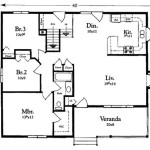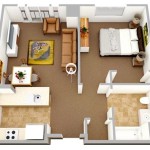Floor Plans for Small Houses: Maximizing Space and Functionality
The increasing desire for sustainable living, coupled with the rising cost of land and construction, has made small house living an attractive option for many. However, the success of living in a small house hinges on a well-designed floor plan. A thoughtful floor plan is essential to maximizing space, ensuring functionality, and creating a comfortable and livable environment within a limited footprint.
Floor plans for small houses require careful consideration of every square inch. The focus shifts from simply fitting in furniture to strategically utilizing space to accommodate daily activities. This article explores key aspects of floor plan design for small houses, focusing on effective strategies for optimizing space and enhancing livability.
Open Concept Living Spaces
One of the most effective strategies for making a small house feel larger is the use of an open concept floor plan. This involves combining the living room, dining area, and kitchen into a single, unified space. By eliminating walls between these areas, natural light can flow freely, creating a brighter and more airy atmosphere. The visual continuity also gives the illusion of greater square footage.
When implementing an open concept design, careful zoning is important. While the walls may be absent, defining each area with furniture arrangement, different flooring materials, or subtle changes in ceiling height can help create distinct zones within the larger space. For example, a rug can define the living area, while a kitchen island can serve as a visual and functional barrier between the cooking and dining spaces.
Open concept living can also improve social interaction within the home. It allows for easier communication between family members who may be engaged in different activities. This design promotes a sense of togetherness and connection, making the home feel more inviting and comfortable.
However, open concept living also has its drawbacks. Noise and smells can easily travel between zones, which may be a concern for some individuals. Careful planning and the use of sound-absorbing materials can help mitigate these issues. Proper ventilation is also crucial to prevent cooking odors from permeating the entire space.
Vertical Space Utilization and Storage Solutions
In small houses, maximizing vertical space is crucial for both storage and creating a sense of openness. High ceilings, even if only in select areas, can make a significant difference in the perceived size of the home. Lofts, mezzanines, and strategically placed shelving can significantly increase usable space without expanding the building's footprint.
Lofts are an excellent solution for incorporating sleeping areas, offices, or storage into a small house. They effectively utilize the vertical space above living areas and create a sense of privacy without requiring a full enclosure. Careful consideration must be given to the access to the loft, with space-saving staircases or ladders often being the preferred choice.
Built-in storage solutions are essential for minimizing clutter and maximizing usable space. This can include built-in shelving, drawers under beds, and storage benches. These solutions blend seamlessly into the home's design and provide ample storage without taking up valuable floor space.
Consider incorporating multi-functional furniture such as sofa beds, ottomans with storage, and tables that can be folded or extended. These items can adapt to different needs and allow for flexibility in utilizing the limited space.
Another often overlooked area is the space above doorways and windows. Installing shelves in these locations can provide valuable storage for books, decorative items, or other belongings.
Strategic Use of Natural Light and Windows
Natural light plays a critical role in making a small house feel larger and more inviting. Maximizing the amount of natural light that enters the home can significantly improve the overall atmosphere and reduce the need for artificial lighting. Properly placed windows and skylights can bring in ample daylight and create a sense of connection with the outdoors.
Large windows are ideal for maximizing natural light. Consider placing them strategically to capture the best views and solar exposure. South-facing windows are particularly effective for passive solar heating in cooler climates, while north-facing windows provide consistent, diffused light without the harsh glare of direct sunlight.
Skylights can be an excellent option for bringing light into areas that would otherwise be dark, such as hallways or bathrooms. They can also add architectural interest to the home and create a sense of spaciousness.
The placement of windows also affects the perception of space. Windows placed on opposite walls can create a visual connection between the interior and exterior, making the room feel larger. Low windows can offer views of the ground, while high windows bring in more light and provide privacy.
Light-colored walls and ceilings reflect natural light and enhance the brightness of the space. Using reflective surfaces, such as mirrors, can also help to amplify the light and create the illusion of greater depth.
Prioritizing Functionality over Size in Room Design
In a small house, it’s crucial to prioritize functionality over simply replicating the layout of a larger home. Each room must be carefully designed to serve multiple purposes and be highly efficient in its use of space. The focus shifts from having dedicated rooms for every activity to creating flexible spaces that can adapt to different needs.
For example, a guest bedroom can double as a home office or a hobby room when not in use. Installing a Murphy bed or a sofa bed can transform the space from a workspace to a sleeping area in a matter of minutes. Incorporating built-in shelving and storage can help keep the space organized and clutter-free.
The kitchen should be designed with efficiency in mind. A well-organized kitchen with ample counter space and storage can make cooking a more enjoyable experience. Consider using vertical storage solutions, such as pull-out pantries and hanging pot racks, to maximize the available space.
Bathrooms can be designed to be compact and efficient. Using a corner shower stall or a wall-mounted toilet can save valuable floor space. Floating vanities and mirrored cabinets can also create the illusion of greater spaciousness.
The entryway should be designed to be functional and welcoming. A small bench or a console table can provide a place to sit and remove shoes. Hooks and shelves can be used to store coats, bags, and other items. A well-designed entryway can help prevent clutter from accumulating in other areas of the house.
Incorporating Outdoor Living Spaces
Extending the living space to the outdoors can significantly enhance the livability of a small house. A well-designed patio, deck, or garden can provide additional space for relaxing, entertaining, and dining. Outdoor spaces can also create a connection with nature and improve the overall well-being of the occupants.
A small patio or deck can be an extension of the living room or dining area. Consider using sliding glass doors to create a seamless transition between the interior and exterior. Outdoor furniture should be chosen to be durable and weather-resistant. A pergola or awning can provide shade and protection from the elements.
A small garden can provide a place to grow flowers, vegetables, or herbs. Raised garden beds can be a good option for small spaces. Container gardening is also a great way to add greenery to a patio or balcony.
An outdoor kitchen can be a valuable addition to a small house. A grill, a sink, and a countertop can provide everything needed to prepare meals outdoors. Outdoor lighting can extend the use of the outdoor space into the evening hours.
Privacy is an important consideration when designing outdoor living spaces. Fences, hedges, or screens can provide privacy from neighbors and create a more secluded and relaxing environment.
Designing for Flexibility and Adaptability
Small house floor plans need to be designed with flexibility and adaptability in mind. As the needs of the occupants change over time, the home should be able to adapt accordingly. This can be achieved by incorporating multi-functional spaces, modular furniture, and flexible design elements.
Multi-functional spaces can serve multiple purposes. A guest bedroom can double as a home office, a living room can be transformed into a dining area, and a kitchen can be used for both cooking and entertaining. This flexibility allows the home to adapt to different needs without requiring major renovations.
Modular furniture can be easily reconfigured to suit different situations. Sofas that can be separated into individual chairs, tables that can be folded or extended, and storage units that can be stacked or arranged in different ways can provide flexibility in utilizing the space.
Flexible design elements can include movable walls, sliding doors, and adjustable shelving. These elements allow the home to be easily reconfigured to meet changing needs. For example, a movable wall can be used to create a temporary bedroom or a larger living area.
Designing for accessibility is also important. Wide doorways, ramps, and grab bars can make the home more accessible to people with disabilities and allow them to age in place comfortably.
In summary, designing floor plans for small houses requires a strategic and thoughtful approach. By prioritizing functionality, maximizing space utilization, and incorporating flexible design elements, it is possible to create a comfortable and livable home within a limited footprint. The successful execution of these strategies will result in a small house that feels larger and more inviting than its dimensions suggest.

10 Small House Plans With Open Floor Blog Homeplans Com

Small House Design 2024001 Pinoy Eplans Floor Plans

27 Adorable Free Tiny House Floor Plans Small

27 Adorable Free Tiny House Floor Plans Craft Mart

These Small House Plans Pack A Lot Of Punch Houseplans Blog Com

10 Small House Plans With Open Floor Blog Homeplans Com

Plan 73931 Detached Guest House Or Tiny With Photos

540 Best Small House Plans Ideas

Small House Plans With S Houseplans Blog Com

Villoresi Small Luxury House Plan Courtyard

